Matador Network's Blog, page 1012
September 17, 2019
Most amazing mausoleums in the world

For some, a simple headstone or grave marker isn’t enough. They want to be remembered with grandeur and make their final resting place a big and fancy mausoleum — that is, an entire building that houses their remains, and sometimes their worldly treasures, in a tomb. Mausoleums may be a grave subject, but when it comes to honoring the dead, they are often elaborately built and decorated to forever enshrine the legacy left by important individuals. Here are seven of the most fascinating mausoleums around the world for travelers to check out. But remember to always be respectful when viewing or visiting these beautiful sites. They are way more than just pretty buildings.
1. Taj Mahal, Agra, India

Photo: YURY TARANIK/Shutterstock
The Taj Mahal is easily one of the most famous monuments in the world, and it has the outrageous tourist numbers to show for it, but many don’t realize that it’s not just a beautiful edifice. Its real purpose is to hold the remains of Mumtaz Mahal, the favored wife of emperor Shah Jahan. It also houses the remains of its builder. It was commissioned in 1632 and continues to be meticulously maintained, though the site’s heavy foot traffic complicates this effort. Located on the Yamuna River in Agra, the massive white marble mausoleum is easily recognized the world over and naturally has a spot on the UNESCO World Heritage list.
2. Mausoleum of the First Qin Emperor, Xi’an, China
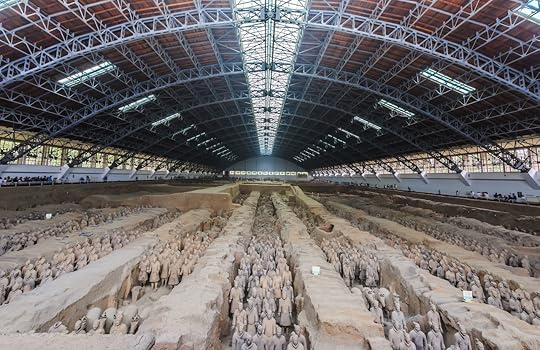
Photo: 4045/Shutterstock
The Mausoleum of the First Qin Emperor, also called Qinshihuang Mausoleum, has a place on the UNESCO World Heritage list for its great cultural intrigue and the thousands of years of history it hides — since construction was finished by 208 BC. Visitors at the site can take in the thousands of famous terracotta warriors, each of them unique, at this mind-blowing mausoleum. Incredibly, it was not discovered until the 1970s when farmers digging a well found more than water beneath the ground. The warriors are located within a dome-shaped tomb meant to protect the emperor in the afterlife. The large compound is comprised of a grave mound, mausoleum constructions, burial pits, and sites of ritual construction, and it’s actually larger in footprint than Egypt’s Great Pyramid.
3. Shah-i-Zinda, Samarkand, Uzbekistan

Photo: Evgeniy Agarkov/Shutterstock
Colorful tiles in hundreds of shades of blue adorn Uzbekistan’s Shah-i-Zinda, which is actually a necropolis that’s a series of tombs housing people both famous and unknown. Legend claims that the sprawling necropolis, now with over 20 buildings — including the 16th-century Kusam-ibn-Abbas mausoleum and mosque, various mausoleums built in the 1300s, and Shirin-Bika-Aga mausoleum — houses the remains of a cousin of Muhammad, the founder of Islam, making it an important religious site. Some visitors to Shah-i-Zinda are making a pilgrimage, so ensure that you remain respectful and modest at all times during your visit.
4. Mausoleum of Hadrian (Castel Sant’Angelo), Rome, Italy

Photo: Blue Planet Studio/Shutterstock
Originally commissioned by Hadrian, a Roman emperor from 117 to 138 AD who planned to use the classical complex as a burial place for himself and his family, the Mausoleum of Hadrian was once the tallest building in Rome. Today, it still stands as a grand beauty on the Roman skyline. The ashes of succeeding emperors were stored here, but the building went on to live second lives as both a fortress and castle — Castel Sant’Angelo. Today, it’s an art and history museum open to the public.
5. Tomb of Jahangir, Shahdara, Pakistan

Photo: Imran’s Photography/Shutterstock
Pakistan’s Tomb of Jahangir is colorful and intricately tiled inside and out with decorative frescoes and stonework. Built for the emperor Jahangir in the 17th century, the mausoleum, perhaps one of the most beautiful buildings in the country, is surrounded by elaborate gardens. It’s free to visit and located near the border with India. Make sure to also visit the nearby Tomb of Nur Jahan, which houses the remains of Jahangir’s wife; it’s much simpler in architectural scope but still beautifully decorated.
6. Lenin Mausoleum, Moscow, Russia

Photo: abadesign/Shutterstock
A sprawling and decorative complex located in Moscow’s Red Square, the mausoleum housing the remains of Soviet leader Vladimir Lenin is a macabre one to visit. The Lenin Mausoleum contains Lenin’s actual preserved corpse on display, which is specially embalmed and maintained on a regular basis. It has been on display in the mausoleum ever since Lenin’s death in 1924. There is a team of embalmers dedicated specifically to maintaining the corpse and ensuring it looks as lifelike as possible. The mausoleum is free to visit.
7. The Great Pyramid of Giza, Egypt

Photo: Waj/Shutterstock
Another one of the world’s most recognizable monuments, the Great Pyramid of Giza located near El Giza, Egypt, is one of the Seven Wonders of the Ancient World. At 481 feet, it was also the tallest man-made structure in the world for nearly 4,000 years. Its construction still baffles humanity to this day. No one quite knows how the pyramid could have been built in 2560 BC without the complex technology and capabilities we now have. Other, smaller pyramids located nearby in the Giza complex include pyramids for Pharaoh Khufu’s wives and tombs for nobles.
8. Mausoleum of Mao Zedong, Beijing, China

Photo: Mario Savoia/Shutterstock
Beijing’s Mausoleum of Mao Zedong houses the remains of Mao Zedong, the leading political figure of the Communist Party of China during the mid-1900s. Like Lenin in Russia, Mao’s embalmed body is on display inside a crystal coffin in the mausoleum, which is located in the famous Tiananmen Square. The site is open to visitors most days of the week and is free to enter, though it’s important to note that you must dress modestly and cannot bring a camera.
9. Imam Husayn Shrine, Karbala, Iraq

Photo: Sajjad Haidar Malik/Shutterstock
The Imam Husayn Shrine in Iraq is a large and colorful mausoleum and mosque. It’s the burial site of Husayn ibn Ali, the third Imam of Islam. After Mecca and Medina, the Imam Husayn Shrine is one of the holiest sites for Shi’ite Muslims, so many of the shrine’s millions of annual visitors are pious individuals making a pilgrimage. As such, the shrine is elaborately decorated in gold and vividly painted tiles and is spectacularly illuminated at night in various colors. Non-Muslims are allowed to visit but should ensure that they are respectful and considerate of the religious significance of the holy spot. 

More like this: This is the happiest cemetery in the world
The post The 9 most fascinating mausoleums around the world appeared first on Matador Network.

Best lodges in Northern Patagonia
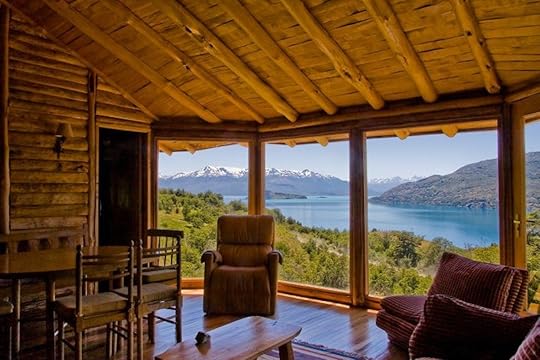
For the Northern Hemisphere, summer is slipping away. If you’re left pining for another few months of summer, the other side of the equator is not as far as it sounds. It beckons with its own summer season that is at its warmest between November and February. South America is a prime spot for a winter escape, particularly if you’re dreaming of Patagonia.
Opt for the northern sections of Patagonia that straddle both Argentina and Chile — like the Lake District, Neuquén, Chubut, Aysen, and Chaiten — where snowy havens melt away into pristine woodlands, flowering mountainsides, and cerulean waterways. There, you’ll find elegant lodges tucked away in the remote wilderness, peacefully devoid of mass tourism. These are the dreamiest among them.
1. Rio Hermoso Hotel de Montaña

Photo: Río Hermoso Hotel de Montaña/Facebook
From the moment you pull up, you’ll feel as if you have woken up as a Patagonian millionaire. It’s easy to forget this is a four-star lodge as the six exclusive rooms overlooking the river feel like home, exuding a rare elegance only captured in the hands of nature.
The fuss-free hospitality urges guests to leave behind the fancy stuff in favor of getting dirty. This is the place to come if you want to spend your days roaming where the golden pumas go, casting a line for world-class fly-fishing, following the sounds of songbirds, or kayaking into the Patagonian wilderness. Top it all off with luxurious linens, roaring fireplaces, bubbling tubs, and exquisite fine dining as the last light fades from the sky.
The main draw of this section of Patagonia is the Route of the Seven Lakes, an unforgettable road trip that passes through 66 miles of Argentina’s famed Route 40. The scenic pathway follows far more than the seven lakes it’s famous for. It offers nature’s best eye candy with lakes, waterfalls, forests, mountains, and beaches worthy of legends.
The area surrounding the hotel is a worthy destination of its own. Lanin National Park holds one of Patagonia’s oldest conservation areas, established in 1937. It’s the ideal place to witness the grandeur of Patagonian trees like the araucania, ñire, lengue, and coihue; stratovolcanoes like Lanin, Villarica, and Quetrupillán; and endless lakes. Wildlife is abundant within the haven, and the park seduces explorers with 25 established trails stretched over its 2,350 square miles.
Getting there: Rio Hermoso Hotel de Montaña is the northernmost lodge on this list, located in the Neuquén province within Argentina’s Lanin National Park. Find it just off the Ruta 40 on the hems of the legendary Seven Lakes Route, 17 miles south of San Martin de los Andes. Guests can arrive by air with a two-hour flight from Buenos Aires to the Chapelco Airport, followed by a 45-minute car ride.
2. El Aura Lodge

Photo: ElAura Patagonia/Facebook
Nearly 250 miles south, intrepid explorers can head to the shorelines of Lago Verde and into the landscapes of one of Argentina’s longest-standing national parks. The Los Alerces National Park boasts more than 700 square miles of remote parklands and was declared a UNESCO World Heritage site in 2017.
El Aura Lodge is the only hotel located within the park boundaries, keeping to the highest standards of both luxury and sustainability. The lodge houses just five opulent cabins that will impress discerning travelers. The property also includes a restaurant, cafe, tea house, and market, plus budget-friendly eco domes and campsites.
The primary allure of El Aura Lodge is the epic landscape and the eco-tours through which to explore them. The lodge hosts an array of unforgettable Patagonian experiences. From here, visitors frequent the oldest living trees on the planet — the Alerces are 3,600 years old — the iconic Futaleufú River, Lago Verde, Lago Menendez, and the 24,000-year-old Torrecillas Glacier. The territory is also prime grounds for wildlife spotting. It’s home to endemic and endangered species like the pudu and huemul deer, mini snow leopards, carnivorous otters, and 126 species of birds including the Magellanic woodpecker.
Getting there: El Aura Lodge is located in Chubut, an Argentine province about 150 miles south of Bariloche and 45 miles north of Esquel. The nearest flights connect from Buenos Aires or Santiago, Chile, to Puerto Montt, Bariloche, and Esquel.
3. Oceano Patagonia

Photo: Océano Patagonia: Wild Coast Residences/Facebook
If warmer temps conjure up images of beaches and turquoise seas, you might be surprised that some of that exists in Patagonia, too. Check into Oceano Patagonia on the Atlantic coastline of the Valdes Peninsula, arguably one of the best places to spot ocean wildlife in Patagonia. The small oceanfront oasis offers the only luxury digs in the tiny village of Puerto Piramides, which services the 890,000 acres of the remote, UNESCO-protected peninsula.
The minimalist, eco-friendly hotel contains 11 luxury condos with panoramic views looking out over the wildlife-rich beach cove. Not only is it the loveliest hotel in the area, but Oceano Patagonia is also actively working toward a LEED (Leadership and Excellence in Environmental Design) certification.
Winter — aka summer in the Southern Hemisphere — is the prime season for seeing for an array of Patagonia ocean wildlife. Among the most popular animals to see are the southern right whales, an endangered baleen species. Guests can literally see them leaping in the bay from their room balcony. But Oceano Patagonia is aligned with the local, sustainable whale-watching organization, Bottazzi Whale Watch, so you can get a little closer by way of whale-watching boat tours between the months of June and December. A well-known pod of surfing killer whales, or orcas, also resides offshore from the Valdes Peninsula. It frequents certain areas of the coastline from February to April when the whales come to hunt seal pups.
The Valdes Peninsula is also home to enormous populations of Magellanic penguins, which nest from September through March; southern sea lions, which birth and breed on the beach from December to February; and elephant seals, which birth from November to December. Several species of unique dolphins — including spinner dolphins, Commerson’s dolphins, dusky dolphins, and bottlenose dolphins — can be spotted year-round.
Getting there: Oceano Patagonia and the Valdes Peninsula are in Argentina’s Chubut province, located about 60 miles northeast of Puerto Madryn. Many visitors arrive via two-hour flights from Buenos Aires to either Puerto Madryn or Trelew, followed by a one- or two-hour drive.
4. Yelcho en la Patagonia

Photo: Yelcho en la Patagonia/Facebook
For those in search of true remoteness, getting to Yelcho en la Patagonia offers an adventure as grand as the stay itself. Unless you’ve got the cash for a private helicopter ride or small charter flights, the journey to this chic, rustic getaway can take a couple of days. It’s so worth it.
Six full-size cabins, eight lodge rooms, and 15 campsites provide the ultimate Patagonian experience in total alignment with nature. It’s situated along the impressive Yelcho Lake of the Los Lagos region, with views of the snowy peaks reflecting over the stunning lake as just one prize for the effort of getting there. There’s also a gourmet restaurant, full bar, lounge, library, viewing deck, and wood-heated jacuzzi, as well as shops for gifts or fly-fishing supplies.
Whether you’re a road tripper or a thru-hiker, this is the ideal territory for embarking on a Patagonian adventure. Located within Chile’s new Route of the Parks, adventurers of either breed can easily step or drive onto the 1,700-mile pathway right from Yelcho Lake. October to May, when snowfall is limited and Patagonian daytime temps hover between the mid-40s and mid-70s Fahrenheit, is the perfect time to do so.
If staying put is more your style, Yelcho en la Patagonia can support any ambition of getting off-grid. The vast property includes its very own beaches, forests, trails, ranchlands, and access to lake activities like sustainable fishing, kayaking, and hiking. Off-site nearby attractions include the Corcovado National Park, Pumalin Park, Alerce Andino National Park, Hornopirén National Park, and the Futaleufú River, just to name a few.
Getting there: The journey to Yelcho en la Patagonia begins with a one-hour-and-40-minute flight from Santiago Chile to Puerto Montt, Chile. (If you fly from Buenos Aires, you’ll need to connect for at least 5.5 hours of air travel.) It’s followed by another 7.5 hours by road and ferry from Puerto Montt nearly 190 miles along the legendary Carretera Austral, the Chilean Patagonian highway, to 30 miles south of Chaiten. Of those 7.5 hours, 4.5 are on ferries that cross the glacial fjords, while the remaining three hours have you driving through isolated, national parklands.
5. Mallin Colorado Ecolodge

Photo: Mallin Colorado Ecolodge/Facebook
The final two lodges are literal neighbors residing on either side of Lago General Carrera, near the small Chilean village of Puerto Guadal. Although it’s unlikely that one would stay at both, the hotels often work together, sharing their precious resources. Yet, the ambiance and activities between the two are spectacularly different.
Mallin Colorado is the most upscale lodge on this list, topping out with mind-blowing lakeside log cabins. Owned and operated exclusively by seven siblings — the second generation of a family of eco-enthusiasts — this Patagonia lodge has an irreplicable story of family history and nature.
Location and charm are only half the mix, though, as exclusivity also takes center stage here. There are just four private log cabins on the site — ranging in size from 325 to 970 square feet — boasting every imaginable comfort of home, plus a six-room inn named the Casa Lenga.
Mallin Colorado also has a clubhouse and a quincho, a grilling house, but the true allure is the private hiking trails stemming out from the lodge. Right from the threshold, you can step into the Patagonian wilderness with virtually no one else on the path. Three exclusive trails rise to glaciers and descend to beaches for anywhere from a 30-minute to six-hour excursion.
The main attraction for guests in either this or the Terra Luna Lodge is the General Carrera lake and the Marble Caves protruding out from the depths. Although still a lesser-known Patagonian destination, the mysterious caves in the middle of the lake might be among the most unique features of the region. Travelers visit the opalescent Marble Caves with a boat ride over the lake that takes them close to Puerto Rio Tranquilo. Although the caves are open year-round, November to February offers the best conditions for being on the frigid water.
6. Terra Luna Lodge Patagonia
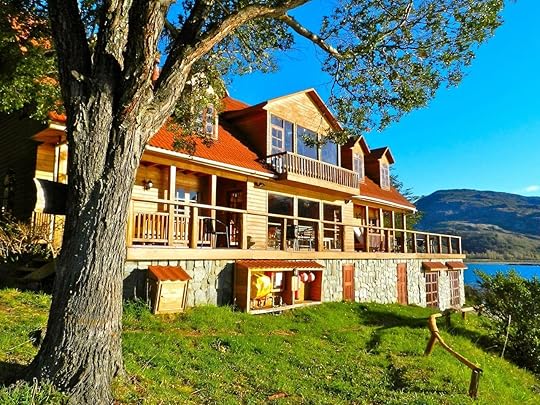
Photo: Terra Luna Lodges/Facebook
On the other side of the lake, Terra Luna Lodge claims an ideal portion of the southeast corner of General Carrera lake. The gargantuan property has accommodations for every type of traveler, as long as adventure is your middle name.
Within the 15 acres, guests can choose from full-size cabins, bungalows, apartments, treehouses, standard lodge rooms, refuge style lodging, camp huts, and igloo dome tents. But, even the epic views, on-site zipline, and kid’s rock climbing sectors pale in comparison to the legendary owner of Terra Luna Lodge and his equally genius side ventures.
Terra Luna Lodge, in combination with the renowned Patagonia Jet boat tours and Patagonia Heli Tours, is the brainchild of Phillipe Reuter. He’s a mountain climbing legend in his own right who has not lost his enthusiasm for the outdoors. He says the property was not conceived to provide five-star luxury, but rather five-star experiences. So, this is the place you want to be if you want an out of the ordinary Patagonian experience.
Phillipe personally creates, pilots, and leads expeditions around Patagonia with all-inclusive trips based on adventure excursions. From one-hour excursions to 20-day trips, adventures include anything from hiking and kayaking to mountain biking, camping, boating, rafting, mountain climbing, skiing, and helicopter rides.
Getting there: Travelers who wish to stay at either lodge must get to Puerto Guadal, located in a very remote area of the Aysen region of Chilean Patagonia. Public transport is rarely available, and most travelers arrive by private car. The closest cities are Coyhaique, 165 miles north, and Cochrane, 38 miles south. The nearest airport is in Airport Comodoro Rivadavia in Chubut, Argentina, with service from Buenos Aires in about 2.5 hours. Both lodges can assist with airport transfer service. 

More like this: There’s a glamping resort in Patagonia, and it just made your dream trip even dreamier
The post 6 unforgettable Patagonian lodges to inspire a trip this winter appeared first on Matador Network.

Poisonous, toxic foods people eat
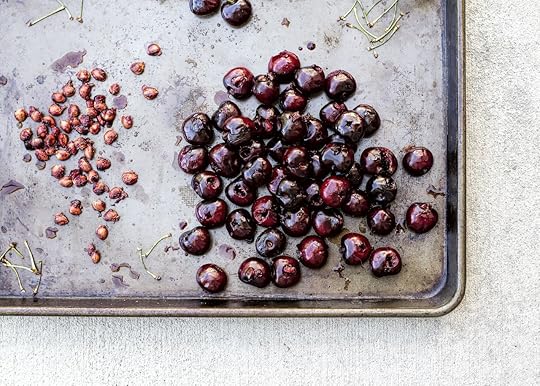
When traveling, it’s not uncommon to come across dishes and ingredients you’re unfamiliar with. Sometimes it can cause second thoughts. Take the traditional raw chicken eaten in Japan, for example, or pufferfish, which has organs that contain a neurotoxin stronger than cyanide. Both are also delicacies, the latter as fugu, which must be properly cleaned before consumed.
Going abroad isn’t the only place you’ll find commonly eaten foods that are also quite toxic, however. A surprising number of grocery-list staples, from fruits and veggies to legumes and nuts, contain hazardous, if not deadly, compounds. Here are nine surprisingly commonplace foods that you probably didn’t realize could kill you.
1. Almonds

Photo: progressman/Shutterstock
Mystery novel readers know that cyanide, a common poison, smells like bitter almonds. That’s because unprocessed almonds contain hydrocyanic acid, which can be lethal. Eating as few as 10 raw bitter almonds could be fatal for a child. The almonds we buy to snack on are sweet almonds, but bitter almond oil is used regularly to make extracts and liqueurs.
2. Nutmeg
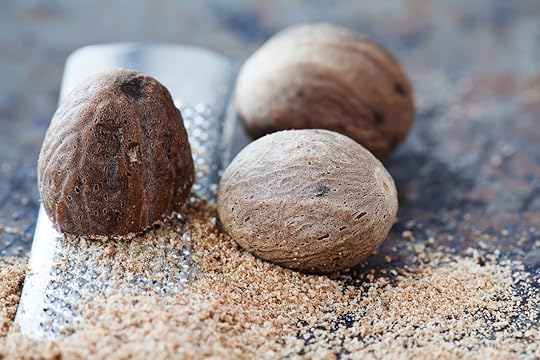
Photo: Besjunior/Shutterstock
Nutmeg is an indispensable spice and a popular addition to both desserts and savory mains. It can also make you hallucinate. Nutmeg contains a psychoactive compound called myristicin that, when consumed in large quantities, has a greater effect than a couple of glasses of eggnog. Other side effects include headaches, nausea, and delirium. Jury’s still out on how much nutmeg is considered toxic, but symptoms are generally believed to start after around two tablespoons.
3. Kidney beans

Photo: Goode Imaging/Shutterstock
Buying bulk dry goods like rice and beans is great for a budget. We recommend sticking to canned kidney beans, however. Uncooked kidney beans need to soak in water for several hours and boil for 30 minutes to rid them of a toxin called phytohaemagglutinin, or lectin, before they’re safe to consume. Eating just a handful of these raw beans can lead to nausea, vomiting, and diarrhea. Fava beans, soybeans, and others also contain lectins, but red kidney beans have the highest concentration by a wide margin.
4. Honey

Photo: Syda Productions/Shutterstock
There’s a myth that honey becomes toxic when you heat it. It doesn’t, but what can be dangerous for young children and pregnant women is eating unpasteurized honey. Pasteurization is a process in which foods are treated with low heat to kill pathogens, removing toxins called pyrrolizidine alkaloids in honey’s case. Consuming more than a teaspoon of unpasteurized honey could result in nausea, dizziness, headaches, or even death in young children or pregnant women. But don’t worry: Healthy adults can keep adding a spoonful of raw honey to their piping hot tea.
5. Cherries

Photo: L.Erin/Shutterstock
Well, cherry pits. Cherry pits contain a chemical compound called amygdalin, which becomes cyanide after it’s ingested. Cyanide poisoning has been documented in people who’ve eaten cracked-open pits, with poison control centers citing a lethal dose as just a couple of pits (though it often takes more). Have no fear if you’ve ever accidentally swallowed a seed whole, but on the off chance you do feel symptoms, they might include fever, headaches, nausea, lethargy, and insomnia. Apple seeds and the pits of other stone fruits, like peaches and plums, contain similar cyanogenic compounds.
6. Potatoes

Photo: alicja neumiler/Shutterstock
Potatoes, tomatoes, and eggplants all belong to the nightshade family, which contains a poison called solanine. To avoid solanine poisoning, keep an eye out for green or sprouted potatoes. The whole plant stores the toxin, so you shouldn’t go eating the leaves or flowers, but the tuber itself can also be dangerous when it’s ready to start, or has already started, sprouting. Before it sprouts, a potato may turn greenish, indicating the presence of chlorophyll, as well as solanine. Store your potatoes out of the sun to avoid excess light exposure and chlorophyll.
7. Rhubarb

Photo: cdrin/Shutterstock
Rhubarb is deliciously tart and fruity, a perfect complement to both sweet and savory dishes. Rhubarb leaves, on the other hand, contain oxalic acid, which can cause irritation to the mouth and throat, difficulty breathing, kidney stones, or even death if ingested — granted, the average adult would have to eat roughly 10 or more pounds for it to be fatal.
8. Cashews
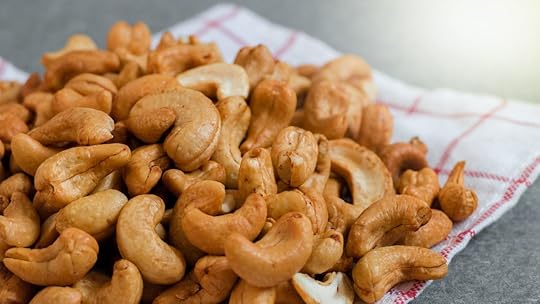
Photo: wanchai/Shutterstock
Raw cashews contain urushiol, a chemical that’s also found in poison ivy. Cashew shells are coated in an oil that contains anacardic acid, a close relative of urushiol that can cause a rash on contact. The cashews we buy at the supermarket are generally steamed or roasted to remove the urushiol, which can be deadly if consumed in large quantities, even the ones that advertise “raw cashews” on the packaging.
9. Mushrooms
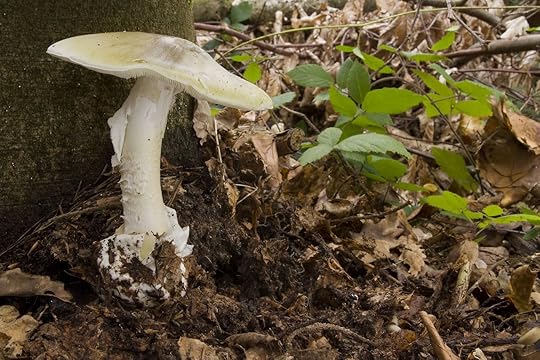
Photo: Alexander Limbach/Shutterstock
Edible mushrooms are tasty, versatile delights, whether you’re adding a handful of porcinis to risotto or swapping out a beef patty for a portobello burger. Other mushrooms are dangerous to ingest, however, like the aptly coined death cap mushroom. It can be near impossible for the average person to tell the difference between edible and poisonous mushrooms in the wild, and fatal foraging mishaps occur every year. So, while you’re safe to keep buying those oyster and cremini mushrooms you love so much, do yourself a favor and stick to sourcing your fungi from the supermarket. 

More like this: The only way to taste these rare fruits in the US is Amazon or Etsy
The post 9 poisonous foods people eat every day appeared first on Matador Network.

Tigers from Tiger Temple in Thailand

Over four years ago, 147 tigers were rescued from a controversial Thai Buddhist temple that acted as an animal attraction, but the future isn’t as bright for the tigers as it was once hoped. Since they were moved from the Wat Pha Luang Ta Bua temple (also known as Tiger Temple), 86 of those tigers have died, many from a virus contracted when the big cats were weakened by the stress of relocation.
The temple was raided by authorities back in 2015 due to alleged wildlife trafficking and unethical treatment of animals. Now, the tragic deaths have prompted conservationists to question whether authorities kept the tigers in safe conditions following their liberation from the temple.
Because the tigers likely would not have survived in the wild, they were being held in small cages at two breeding stations, where many contracted the canine distemper virus. This condition is treatable with proper food and supplements, but according to Edwin Wiek, founder of the Wildlife Friends Foundation Thailand, a limited government budget made the necessary assistance impossible.
“To be very honest,” he said to the BBC, “who would be ready to take in so many tigers at once? The authorities should have asked for help from outside, but instead insisted on doing all work themselves.”
Although Thailand has pledged to reduce the number of tigers held in captivity, that number still continues to rise. According to the BBC, around 2,000 tigers are being held captive in Thailand, mostly by private individuals. 

More like this: 7 epic places to see Bengal tigers in the wild
The post Half of the tigers rescued from Thailand’s infamous Tiger Temple have died appeared first on Matador Network.

Ashlan-fu is traditional Kyrgyz food

There are rows of vendors and shops at the Bugu Bazaar in Karakol, Kyrgyzstan. Each is organized by theme, like jewelry and household items. As I followed my Destination Karakol food tour guide, we approached the most important row of them all: ashlan-fu alley.
Ashlan-fu is a popular dish with Chinese origins that’s synonymous with the city. The spicy soup is typically served cold, and includes pulled Laghman noodles, starch strips, egg, meat, garlic, tomatoes, crushed red peppers, and vinegar. It’s the perfect salve for the many backpackers on their way to and from some of the country’s best adventure destinations and hikers in need of a hearty meal.
On ashlan-fu alley, I’m led to Saida’s, a location that serves an average of 600 bowls a day at just 30 Kyrgyz som a piece (less than 50 cents). When we arrived, it was filled to capacity. Still, the kitchen staff of just two women put together bowls of ashlan-fu by the half dozen with ease. I was salivating as our guide placed the individual bowls on the table in front of us along with extra chili and a basket of fried bread. As we dug in, our guide told us the lunch crowd was light compared to what you’d find on a Sunday. He motioned us forward as if to reveal a secret, and with a playful smile said, “That’s because ashlan-fu is thought by many to be a hangover cure.”
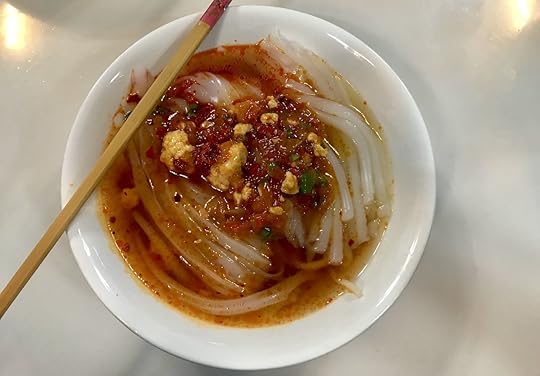
Photo: Jen Ruiz
On Sundays, I learned, you can expect to see the same faces in ashlan-fu alley that you saw at Fat Cat, a local favorite bar, on Saturday night. The Kyrgyz people have a responsible drinking culture and don’t consume copious amounts of alcohol, but they love a good party. Particularly when it comes to nuptials. Perhaps that’s why one wedding party asked the shop owner to prepare 400 dishes of ashlan-fu to-go for their ceremony.
While the soup is sometimes served warm in the winter, it’s traditionally served cold, which offsets the strong spice and vinegar. The noodles are handmade and stretched long to represent a long life. The opaque starch strips are made with potato, corn, or beans by allowing the starch to cool into a mass before being carved into shape with a grater. It’s a process I tried myself the next day while having lunch at a Dungan village.
Ashlan-fu comes from the Dungan people, a Chinese-Muslim minority that fled to Kyrgyzstan (at the time a part of imperial Russia) following a failed revolt in China in the late 1870s. The Dungans who made it to Kyrgyzstan were farmers new to a region of many nomads. One of the primary villages they settled is Yrdyk, just outside of Karakol. The community was accepted by the people of Russia, in large part because of the farmed crops and dishes like ashlan-fu. In 1897, two Russian writers described Dungan cuisine as “very tasty and of great variety.” The Dungan diaspora wasn’t as embraced during the Soviet years. Yet ashlan-fu didn’t fade into obscurity.
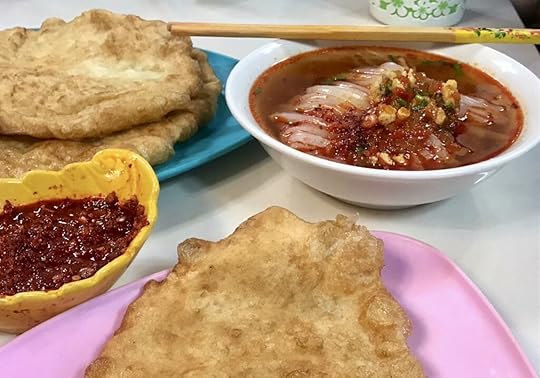
Photo: Jen Ruiz
Today, the dish is just as popular as ever — especially for the late night (and morning after) crowd on the always-open ashlan-fu alley. For another taste of the traditional dish, Destination Karakol offers a Dungan Family Dinner experience where you can learn about history, culture, and, yes, cuisine. The hosts are local families near Karakol who agree to have visitors for lunch, allowing you to sample an eight-course meal in their home that includes assembly of your own ashlan-fu dish.
I watched our host run through the process twice before attempting it myself. The noodles were already in the bowl. My job was to add premixed spices, grate the starch strips, and finish the dish off with vinegar. The starch was gelatinous and more difficult to grate than I anticipated, coming out in mismatched chunks instead of uniform strips.

Photo: Jen Ruiz
The taste more than made up for my lack of craftsmanship and I ate it all before remembering to pace myself for seven more dishes. Each family has their own secret recipe, adding a distinct flare to an otherwise common dish. The basic elements remain in place but no two households serve the same meal. Hot or cold, spicy or mild, vegetarian or meaty — it’s easy to customize ashlan-fu the way you like it.
The one thing you’re guaranteed consistency with is the satisfied feeling you get after consuming a meal that gets your blood flowing and fills your belly after a night of celebrations. 

More like this: Naxi cuisine is the Chinese food you’ve been missing out on
The post Kyrgyzstan’s traditional hangover cure is a mix of history and assimilation appeared first on Matador Network.

Auction of Anthony Bourdain’s stuff

A cache of personal objects left behind by Anthony Bourdain, the host of the award-winning CNN travel and food show Parts Unknown, who passed away in June 2018 at the age of 61, will be auctioned off for charity in October.
According to The New York Times, the majority of the proceeds — around 60 percent — will go directly to his family: his wife, Ottavia Busia, from whom he was separated at the time of his death, and his daughter, Ariane. The rest will be donated to the Culinary Institute of America, to fund a study abroad scholarship. The new scholarship, which will bear Bourdain’s name, will allow the recipient to spend a semester abroad studying an international food-related topic of their choosing.
Though Bourdain’s personal assistant Laurie Woolever maintains that Bourdain became selective about trinkets and gifts he decided to accept (and keep) during his travels, the 215-piece collection is an impressive testament to his interests and hobbies — and also speaks to the long list of notable friends he kept close throughout his life.
Art by Ralph Steadman (best known as Hunter S. Thompson’s illustrator, companion, and collaborator, and a friend of Bourdain’s who was featured in the London episode of Parts Unknown), Bourdain’s chef’s knife, manuscripts of his own books, his personal records, writing desk, and paintings by John Lurie will all be included in the auction. Items of Bourdain’s clothing will even be available, including a US Navy bomber jacket. The total collection is estimated to be worth between $200,000 and $400,000.
The auction is being conducted by Lark Mason, a frequent guest on Antiques Roadshow. Though Mason didn’t know Bourdain, he told the Times that he thinks Bourdain’s simple possessions helped “ground him” in the midst of his “turbulent life.” 

More like this:
The post Anthony Bourdain’s belongings will be auctioned off for charity appeared first on Matador Network.

Libby Vincek discusses experience

Life-changing travel job postings can seem a dime a dozen these days, with short-term opportunities regularly cropping up for such random activities as babysitting sea turtles in the Maldives or working as a housekeeper for the Queen of England. As tempting as the posts may seem, your odds of landing one of these gigs generally fall somewhere between winning the lottery and getting struck by lightning. Even if you do win one, what happens when it’s over? How do tell your boss or partner you’re about to bounce to the other side of the world for a while and convince them to keep your spot warm for you upon return?
Last winter, Libby Vincek had the opportunity to find out. After coming across an online ad, Vincek received the opportunity of a lifetime — she was selected as the official “Local Traveler” in a campaign dreamt up by Thailand’s tourism authority and travel company DreamJobbing. The contest aimed to send one traveler to Thailand to “live like a local” and visit a collection of often-overlooked places in the country, eat street food like a pro, and generally embed themselves into Thai culture for a few weeks. And, perhaps most importantly, the entire experience would be filmed for an Amazon Prime series.
Vincek took off in early 2019, living with locals and attending cultural festivals. The series, The Local Traveler in Thailand, is now live, and the experiences from the trip are now memories. Matador Network spoke with Vincek about the experience to find out how “dreamy” these travel gigs actually are. Here’s a little background on her trip.
As the job and the resulting TV show intended to show what life is like in Thailand and how a solo traveler can fit into it, one stipulation was that she had to stay with local residents, not in hotels, hostels, or convenient Airbnbs. A local hosted her in each location, but she had to find her way to them.
The itinerary avoided major tourist hotspots in favor of foods, places, and events typically experienced only by locals — festivals in Isan, rural mountain areas, family recipes, and the like.
The trip lasted for three weeks. She traveled with a film crew but was responsible for making last-minute trip planning decisions on her own. She was essentially a “solo traveler.”
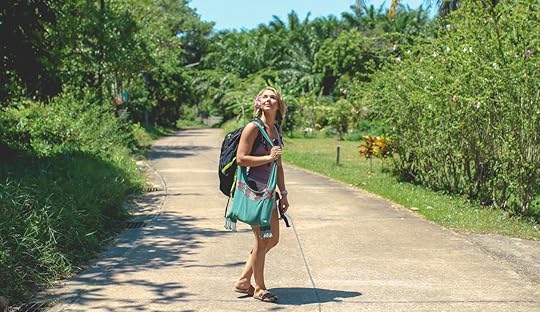
Photo: Libby Vincek
Was everything well-organized, or did you have to do a lot of “trip planning” yourself?
The moment I landed in Bangkok, my experience felt like it was in my hands and in the hands of everyone I encountered. I learned, very quickly, that people were very willing to help you find your way around the city — that’s if they can understand you. I knew that my crew was aware of where we were and where I was ideally supposed to end up, but it was up to me to find my way.
I was more determined than ever to find my way around Thailand towards the locals I was being guided to. The surprises and the challenges of finding my way along with the “spur of the moment” planning made the trip as exhilarating and as incredible as it was. I learned so much about the culture, and what it really means to be immersed in that culture, because of the uncomfortable situations I had to work through to become comfortable.
What was the reaction of the locals in Thailand when you first met them? Were they excited to have you there?
The locals were very friendly and welcoming. They loved having a new face in their community. Rather than feeling like a tourist, they made me feel like a friend coming over for dinner. They were more than excited to meet someone who was unfamiliar with their lifestyle, and found so much joy in immersing me into their culture.
Was there a lot of work expected of you before the trip?
At first, I had no idea the work that was expected of me. I just knew that I was going to Thailand and I was going to roll with the flow when I got there. There was SO much more to that than just rolling with the flow. I took so much pleasure in the responsibilities I had being the local traveler. I wasn’t just experiencing Thailand. I had the honor of sharing a beautiful country with people who may not ever be able to travel there and inspire people to see it for themselves. I was able to tell a story of a new experience as I was learning all about it in the moment, and form relationships with the locals as quick as possible to allow them to feel comfortable enough to open up in front of the camera.
Oh, and I had to figure out where I was going. I couldn’t have enjoyed the hurdles more, though. That is when I found myself truly living my passion. I was filled with what it took for me to overcome obstacles so that I could relay to the people who wanted to travel and embrace this experience after me.
Did you have to quit a job, or leave a partner at home? What was that process like?
I had recently accepted a temporary job with Hallmark in California. During that time, knowing that there was an ending to it, I knew that was coming and I had to deal with it, but they had offered me another opportunity and literally that day was when I found out about Thailand.
They allowed me to work until I left for Thailand, which was great but I had no idea what I was going to do when I got back.
How about after the trip and during the TV production process?
I was a film major in college. My degree is in film, television, and digital media from TCU. I was thriving during this process. Not only was I enjoying my favorite hobby of traveling, but doing it with a film crew and embracing my passion for hosting — it was like I was literally living my dream. This was really where it began to really soak in what I was given the opportunity to do. The more I narrated my experience and relived it, the more I learned about culture and life itself outside of my world. I saw myself grow, I saw myself make mistakes, and I saw myself become a better traveler. It’s almost impossible to embrace the present in crazy situations because we find ourselves thinking about what’s next. This was where I really got to live this experience.

Photo: Libby Vincek
Were there any parts of the experience that were awkward or that made you laugh a bit at how weird the moment was?
Oh my gosh YES! The one that sticks out the most, in particular, is when I was traveling to the Sup Don Pai bridge. I rode this tuk-tuk up to a mountain but it got to be so dark by the time I arrived to my destination that I was lost. There were no lights at this temple. I saw huge unlit statues of Buddha, small temples and buildings, but no people.
I was walking around, nervously looking at my crew to help me, and my director was just like, “Where are we going, Libby?” And I’m just looking at him like “I DON’T KNOW, Z! WHERE AM I GOING?” I saw a young monk run off in the distance and I felt immediately like I was intruding. I was walking around as if I was in a haunted place. I saw these stadium lights in the distance so I started walking toward them — I stepped up a small hill onto a path through these bushes and suddenly came this huge opening and there were 30 plus monks worshipping under a tree.
I begin to hear this chanting over a microphone and humming — I hear whispers yelling “foreigner” in the background from a few of the teen monks to each other. Well, yeah, just imagine you’re in your nightly prayer routine and then out of nowhere you see this blonde female in braids with a giant backpack, holding an orchid, being followed by a camera crew. I ‘d say that’s pretty foreign.
I’m narrating to my director how I’m feeling when all of a sudden they start to worship loudly in prayer and my eyes got as big as my backpack. My heart dropped, and I freak out because I really feel like I’m intruding. The last thing I wanted to do was disrespect anyone in this country, so I immediately (mid-sentence) drop my head, bring my hands together and think, this is SO REAL right now! They’re not performing for anyone — they’re worshipping like they do every night. This is the real historic, traditional Thai culture, this is real Buddhism, and of course, I begin to cry. I didn’t care how that was going to betray on camera. It was real and raw. I knew this was something important, so I moved on to look for where I was really supposed to go and eventually found my way to the temple to meet my local.
Since then, has this opportunity led to other opportunities, or to you making any major decisions about your life? What’s coming up next?
Oh gosh, this really has opened up some doors for me, and not only that, but has given me confidence and a stronger passion for something that I had previously just thought I enjoyed. It has shown me what I want to do in life and has led to me meeting some really, really incredible people. I hope that more Local Traveler documentaries are in my future. I want to travel the world and tell the stories of people’s cultures that deserve to be told. I want to bring a world that is out there to people who would never be able to see it for themselves. Being from such a small town, I have realized that so many people have such closed minds as to what is out there. Just with this documentary, I’ve seen how my small town friends and family have been impacted, seeing a culture that is so different than theirs, and having the opportunity to show that to them and impact them — that makes this brand, this experience, so special.
I’ve since moved to Nashville to be a lead trainer for an upcoming F45 studio here, and for now, I’m helping impact people’s health and wellness. While doing this, I will continue to work toward building the Local Traveler brand and one day hope that these two worlds can collide. I will always have the heart to travel and meet new people, so wherever I am and whatever my job is, that is something I will always do.
So what did you end up doing when you got back?
At first, I was happy to be home because in Thailand, it was like I was living other people’s lives, and I was ready to live my own. But then I realized I didn’t know what to do. It was a total culture shock. I had just recently moved to California, so I was getting back to a life where I wasn’t comfortable yet and was adjusting already.
I was able to take March as it was. I had some small jobs set up, but this experience motivated me to find what I wanted my life to be like, and by living with other people in Thailand it motivated me to really find myself and figure out what I wanted to do. This trip really taught me to allow reality to shape who I want to be, and I think it’s incredible that travel can motivate you to live a bigger, and maybe even better, life. 

More like this: Delta is hiring 1,000 flight attendants by January 1, 2020
The post I won a dream travel job off social media. This is what it was like. appeared first on Matador Network.

‘Downton Abbey’ castle on Airbnb
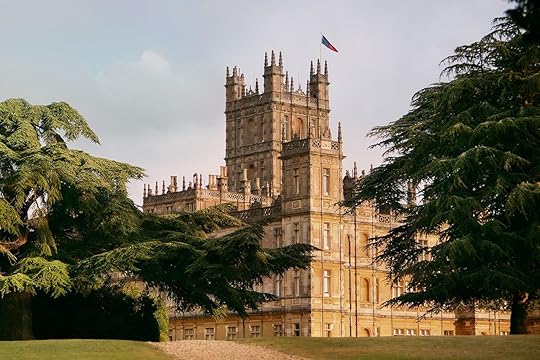
If watching Downton Abbey had you dreaming of living the high life with the Crawleys, now is the time to make that dream come true — almost. Fans of the British period drama are being given the opportunity to spend one night in the castle where the show was filmed, courtesy of Airbnb.

Photo: Airbnb

Photo: Airbnb
In celebration of the release of the Downton Abbey movie, the Earl and Countess of Carnarvon — who own and reside in Highclere Castle in Hampshire — posted their home on the accommodation rental website.

Photo: Airbnb
The castle is a whopping 100,000 square feet with 300 rooms and views of over 1,000 acres of parkland. The two lucky fans will be welcomed at tea time by Lady Carnarvon, the owner of the castle. Later they will enjoy cocktails and a three-course dinner with the Earl and Countess of Carnarvon in the State Dining Room, while being waited on by Highclere Castle’s own butler. The next day, after breakfast, you’ll be given a tour of the magnificent estate.

Photo: Airbnb
Reservations for the castle open on October 1, and are only valid one a one-night stay on November 26 for two guests. While you might think this experience would cost a royal ransom, it’s actually just $186. To improve your odds of being chosen, when you make your reservation be sure to mention how passionate you are about Downton Abbey in your message to the host. 

More like this: 7 castles to visit in France besides Versailles
The post Spend one night of luxury in the ‘Downton Abbey’ castle, now available on Airbnb appeared first on Matador Network.

September 16, 2019
Best cideries near Ithaca, New York

I’m busy making friends with the calico cat sunbathing in a window at Blackduck Cider‘s Ovid, New York, tasting room, when I hear, “That cat isn’t fat enough to eat yet. We’ll wait until fall, then we’ll roast her.” I turn around to find John Reynolds, founder and head cider maker, emerging from the cluttered storage area.
Reynolds is an opinionated and passionate farmer with a sense of humor, and he focuses on producing extraordinarily delicious wild fermented cider. He’s not alone. Ithaca has 10 cideries in a 30-mile radius, making it the highest-density cider region in the state, including some of the best cider makers in the country. The region is just waiting on the recognition it deserves.
A couple hours before I met Reynolds at Blackduck, I arrived in downtown Ithaca via OurBus, which starts at New York City’s Port Authority and goes directly to the city. Ithaca recently received a grant from the state of New York to promote the city’s award-winning cideries, and Visit Ithaca uses a portion of the money to provide discounted round-trip tickets (around $30, depending on the day) for the “Cider Express special” bus ride.
The bus is comfortable enough, air conditioned, quiet (by mandate), and the drive to Ithaca is a feast for the eyes. I couldn’t get the WiFi to work on my phone, so I mostly stared out the window at the clear, rocky waters of the Delaware River, the rolling green hills, dense forest, and the fields of corn and yellow Goldenrod.
The bus stops just outside the city center, where I met my companions dispatched from the tourism office to shuttle me between cideries. If you’re keen to discover Finger Lakes cider, it’s best to do so by car as long as you have a designated driver or plan on tasting rather than drinking (though there are carless ways to get in the action — more on that below).
These are some of Ithaca’s must-visit cideries, in no particular order.
For the cider newcomer: Finger Lakes Cider House

Photo: Allison Usavage Photography
Finger Lakes Cider House is the home of Kite and String cider. Located in Interlaken just a short distance outside Ithaca, it’s one of the most popular cideries in the Finger Lakes. In 2008, the founder, Garrett Miller, and a group of friends arrived at Good Life Farm (home of the cidery and adjoining cafe) with nothing but shovels, a few horses, and their bare hands, and they began cultivating the land.
Miller didn’t know much about cider when he bought Good Life, but it soon became clear that the land could support an orchard. So Miller switched his focus to building a cidery. Today, Kite and Sting uses a mix of apples from the Good Life orchard and from farms within a couple hours of the Cider House.
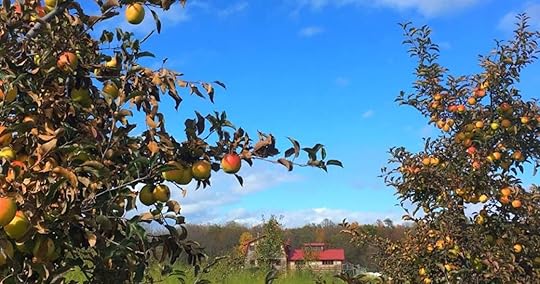
Photo: Finger Lakes Cider House/Facebook
While Miller and I wander the certified organic farm, his face lights up at the mention of sustainable farming.
“I have lots of opinions about the word sustainable,” he says, clearly excited.
Miller explains that he tends to avoid using the word, instead referring to his farming practices as regenerative. He focuses on helping the land “heal and recover” using non-traditional methods. For instance, in past years, he’s let turkeys roam in pens in his apple orchard to help fertilize the ground. He also plants cover crops like millet, sunflowers, clover, peas, and buckwheat. The cover crops aren’t for harvesting but are grown to add nutrients to the soil, naturally control pests and erosion, and limit the growth of invasive weeds.
“This farm used to have two species: corn and the worm that ate the corn,” Miller jokes. Now, the biodiversity of the farm is beginning to show signs of recovery, like the tree frogs that dot the branches of his peach trees and act as an all-natural pest repellent.
While Good Life Farm is the paragon of environmentally conscious farming, I’m here for the cider. Kite and String’s cider is as friendly and approachable as Miller himself. It’s equally suitable for cider newcomers and more experienced drinkers. I especially enjoyed the Glacial Till, which has the taste and texture of a stone-washed dry riesling. However, the real draw is Pioneer Pippin, the two time Best in Show winner at the Governor’s Cider Cup.
Where: 4017 Hickok Rd, Interlaken, NY 14847
For the adventurous drinker: Blackduck

Photo: Visit Ithaca
By the time we left Finger Lakes Cider House, my head was buzzing with visions of farmland blossoming with apple trees and vibrant green vegetation while the natural wildlife, from bunnies to coyotes, makes its homes in the brush and the nearby woods.
Then we arrived at Reynolds’ Blackduck tasting room (so named for Reynolds’ obsession with ducks; his property is home to many “geriatric” ducks as he lovingly refers to them). The sparse bar has just enough standing room for around five people and a sign outside listing operating hours alongside the caveat “or by chance.” The wood paneled room is lined with dusty old wine and cider bottles; the only sign of the modern world is a WiFi-enabled register at the front. It’s as no frills as a farmhouse can get up here. It’s all about the cider, no distractions allowed (except that calico, who kept drawing me to her window). After all, the Blackduck motto is, “Cider is life.”
Blackduck is certainly environmentally friendly, though it operates somewhat off the grid. Reynolds refuses to be certified as organic by the USDA because he has fundamental disagreements with the agency’s standards.
Reynolds’ cider is unfiltered and wild fermented, meaning he doesn’t inoculate the cider with yeast to initiate fermentation. This also means he has less control over the cider’s final flavor. Some of the apples he uses are wild foraged while the rest come from his Daring Drake orchard (the duck theme is no joke). His explanation of his cider’s ingredients is short and sweet: “No, nada, nothing. It’s fruit, whatever is on the fruit, and whatever drips off my brow.”
Though the wild fermentation process is cidermaking at its most natural, it’s relatively uncommon to find wild fermented cider at your local wine store.
“There aren’t 10 of us [wild fermenters] in the US that aren’t full of shit. [Americans] want bubbles and they want sugar,” Reynolds insists. Then he backtracks, taking a softer approach. “They want cleaner flavors.”

Photo: Visit Ithaca
“Wild fermented” might conjure up assumptions that the flavors are confused or rotten. The opposite is true. Take Blackduck’s Woody cider. The flavors are layered and complex, each one bursting on your palette like an Everlasting Gobstopper. And though there is a distinct funk, Woody is also fresh, with a surprisingly crisp, clear bite — much closer to a burbling clearwater creek than the muddy puddle you might be expecting due to its cloudy complexion.
Woody was not only the best cider I tried on my visit to the Finger Lakes but also the best I’ve tried to date anywhere — and I drink quite a bit of cider in my off time. Blackduck’s delightfully tangy and briney Perry cider (that’s cider made with pears) is another popular choice — just be warned: It will likely shock your senses.
Where: 3046 Co Rd 138, Ovid, NY 14521
For the spiritual drinker: Redbyrd
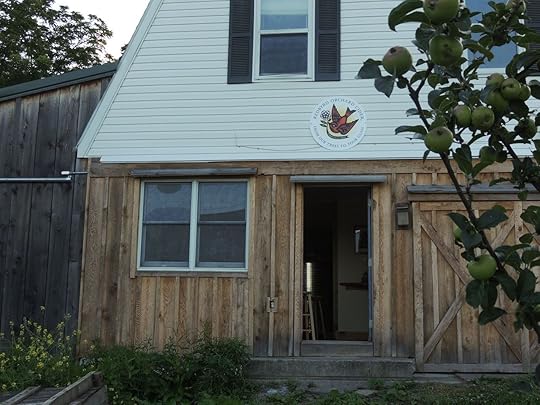
Photo: Visit Ithaca
Redbyrd’s charming tasting room, which fits just three stools, sits inside a little hillside farmhouse. Inside, the burly Eric Shatt, who runs the cidery with his wife Deva, stands behind the wood bar. Shatt is not just a cider maker, he’s also the farm manager for Cornell’s apple orchards, which serves as a “living laboratory” for students studying agriculture and fruit production.
The Redbyrd farm is certified biodynamic, a form of holistic agriculture established in 1924 by the Austrian philosopher Rudolf Steiner. Schatt discovered the practice while working in the wine industry and has used biodynamic practices on his farms for around a decade. Though biodynamic farming is both sustainable and organic, to hear Schatt describe it you’d think it’s sci-fi.
“One of the philosophies around biodynamics is that there are infinite forces playing on the Earth,” explains Schatt. “There are life forces beyond what we can see and recognize. [Biodynamics] works to enhance and harmonize those forces,” Schatt continues. “Why is the moon the only celestial body that influences the rhythms of the Earth? When different planets are in different phases, and constellations, how does that affect plants and water? It’s a complete system approach to agriculture.”

Photo: Visit Ithaca
Biodynamic farming might sound like witchcraft, but its principles are sound: Farmers encourage animal and plant biodiversity and recirculate nutrients into the soil through what are known as preparations — farming practices that resemble pagan rituals.
“Biodynamic farmers put compost into a cow horn and bury it in the ground, and the cow horn acts as a funnel — it’s capturing this life energy and concentrating it into the compost, so the compost holds these forces.” Schatt pauses and bursts into laughter. “A lot of people think its really kooky and a waste of time, but I think it works!”
Schatt’s spells seem to be working, because his cider is exceptional. Redbyrd’s dry rosé cider is grown up with just a hint of sweetness, perfect for easy drinking. The sparkling Celeste Sur Lie is another revelation. The texture is creamy and silky, and it tastes of buttercream and honeycomb — again without veering into saccharine territory. Most folks, however, reach for the Workman Dry, a cider named for its approachability.
Where: 4115 Newtown Rd. Burdett, NY 14818
For the community-minded drinker: South Hill Cider

Photo: Visit Ithaca
In 2003, Steve Selin, a singer, fiddler, and guitar player in Rose and the Bros, stumbled upon a neighbor’s farm filled with wild apple trees. As we walk through his orchard, he explains that by “happy accident” the apples happened to be perfect for cider. He began making cider at home and bringing kegs of his home ferments to shows.
Friends and fans loved his cider so much that he decided to start making it full time. In 2013, he began cultivating his own orchard. His trees, like those at Good Life Farm, are still in the process of producing enough fruit to support South Hill Cider on their own. To supplement his own apples, Selin often goes back to his roots, foraging apples growing wild all over the Finger Lakes.
One of Selin’s hobbies is to keep track of all the wild apple trees he stumbles upon, either growing in the forest that abuts his land, on the side of the road, or abandoned orchards. He, like many other Ithaca orchardists, is beginning to graft wild seedlings onto his apple trees.
“[Wild apples] are offspring of the apples that settlers planted but have been wild for generations,” Selin says. “Cider is a totally wild food.”
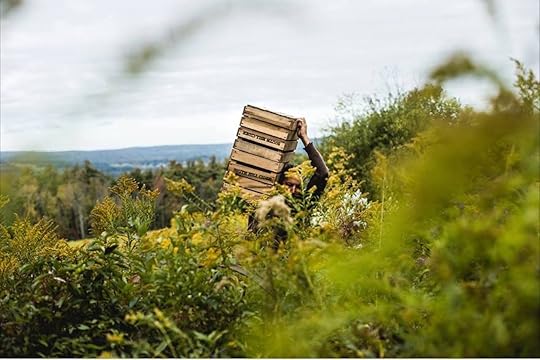
Photo: South Hill Cider/Facebook
Grafting is incredibly beneficial to both apples and orchards. Major commercial varieties like honey crisp and red delicious dominate now, but there used to be hundreds of apple varieties in New York. By grafting wild seedlings onto orchard-grown trees, farmers help cultivate a wider range of apples, using diversity to help ensure the fruit’s long-term survival. The practice is also a natural defense against pests and disease.
The go-to South Hill Cider is Old Time, a crisp, off-dry cider with a clean finish — a perfectly executed classic. For something more adventurous, try Packbasket, Selin’s wild fermented cider made with 100 percent wild foraged apples.
Selin’s first tasting room for South Hill Cider opens on September 19; he hopes it will also double as a welcoming neighborhood hang out.
Where: 550 Sandbank Rd, Ithaca, NY 14850
How to experience Ithaca cider without a car
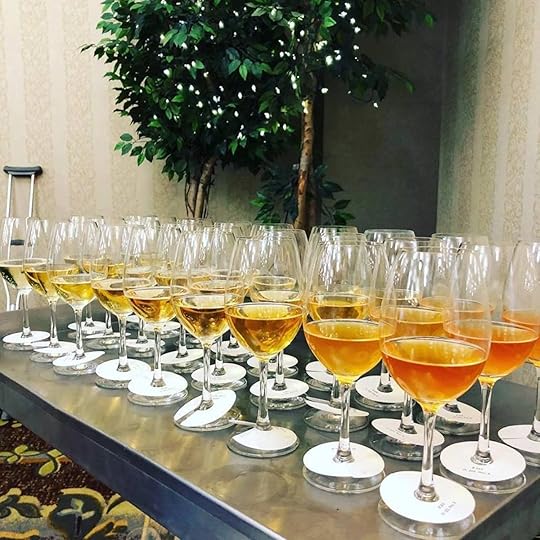
Photo: The Cellar d’Or Wine & Cider/Facebook
If you’d rather not rent a car once you arrive in Ithaca on the “cider bus,” don’t panic: Ithaca cider is still within your grasp. Here are more ways to taste the drink everyone in the region is talking about.
Take a tour: Experience! The Finger Lakes offers the sommelier-led Luscious Libations tour, which visits wineries and cideries in the area. If you’d prefer to stay in the city, Ithaca Is Foodies offers a craft beverage focused culinary tour of downtown Ithaca, which stops at bars and breweries. Just be sure to book in advance, because these tours fill up fast in the fall.
Rent a bike: In 2013, Ithaca’s farmer’s market came in at number nine on the 101 Best Farmers’ Markets in America list. If you’re visiting during the weekend, rent a bike and ride up the Waterfront Trail, which connects to the market and nearby Stewart Park. The market is 30 miles long, and 10 cider makers set up shop there every Saturday and Sunday.
The Cellar d’Or Wine & Cider: If you’re planning to spend the weekend in Ithaca (hint: you should) you’ll need supplies. You can find bottles of the best Ithaca cider at The Cellar d’Or wine shop. There’s cider on tap to fill up growlers, and you’re welcome to taste before buying.
Finger Lakes Cider Week: The best time to take the bus to Ithaca is for Finger Lakes Cider Week, which has 30 events showcasing the area’s cider (25 of which are taking place in Ithaca) from September 27 to October 6. Redbyrd and Finger Lakes Cider House are holding tastings and orchard tours while South Hill is hosting a late-night dance party. If you’re staying in downtown Ithaca, local restaurant Coltivare is holding a cider pairing dinner, and Cornell Orchards will open its doors to visitors as well. This map shows every location where cider week events are taking place to help you plan exactly which spots to visit during your stay. 

More like this: How the Hudson Valley became the best region in the US for craft beverages
The post The best place to drink cider this fall is Ithaca, New York appeared first on Matador Network.

Best things to do in Lund, Sweden
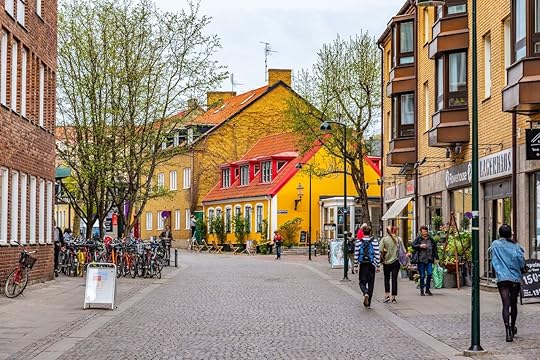
Lund, Sweden, is home to the largest university in Scandinavia, drawing not just Nordic students but also exchange and degree students from around the world. Lund’s students give the ancient city of 90,000 a youthful energy. You don’t need to be an undergrad, though, to enjoy this dynamic town. With its regal architecture and cobblestone streets, Lund is a perfect place to travel back in time while still enjoying all the advantages of a modern, lively city. Here are some of the best ways to enjoy a day or two in Lund.
Admire the imposing architecture.
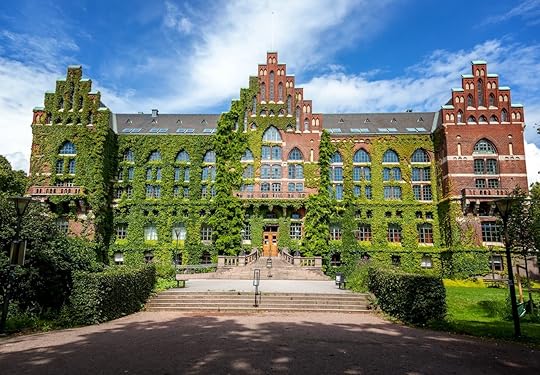
Photo: Olesya Kuznetsova/Shutterstock
Lund’s cathedral is one of the most iconic buildings in town, dominating the city center with its twin towers and romanesque architecture. Consecrated in 1145, it is today a symbol of Lund. You can visit by yourself or, if it’s summer, through guided tours; the crypt also holds an exhibition of historical artifacts. The green area around the cathedral, called Lundagård, is an ideal spot to picnic on the grass while admiring the nearby historical buildings.
You’ll find medieval buildings scattered around the city, which was founded more than a thousand years ago. One Medieval building not too far from Lund is the Liberiet, which was built in the 1400s to serve as the library for the cathedral.
Lund University’s buildings, though, date back to the turn of the last century. The school’s main building, an imposing neoclassical structure, was inaugurated by Sweden’s King Oscar II in 1882. Although Lund’s library is over 350 years old, it moved into its unique red-brick building, with huge arched windows, in 1907. Other buildings dating to that period include the regal Grand Hotel Lund near the train station. Lund’s second-largest church, the Allhegonakyrkan (All Saints’ Church), inaugurated less than 130 years ago, is an underrated neo-gothic gem.
Wander the cobblestone streets and enjoy a fika coffee break.
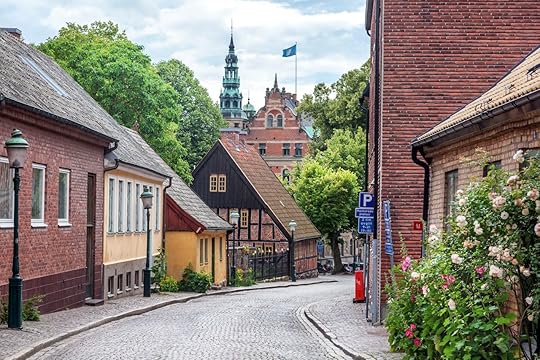
Photo: Olesya Kuznetsova/Shutterstock
The best way to take advantage of the charming streets of Lund is probably to wander and get lost in them. Follow the cobblestone streets and alleys, each with their own distinct personality, as you admire the colorful little houses. In spring and summer, they’re surrounded by flowers. Stop in the hidden shops tucked in between the houses. You might meet a few cyclists or seniors walking their dogs on the way.
When it’s time for a break, stop in a coffee house to have fika, an essential part of any visit to Sweden. Much more than just a coffee break, fika is a cozy moment to chat over sweets and a hot beverage. It’s a cultural tradition that Swedes enjoy at least once a day. Fika is also the perfect chance to try local Scandinavian pastries. Cinnamon rolls and chocolate balls are always good options, and locals say St. Jakobs has the best cinnamon rolls in town.
If you’re there in winter, you’ll find seasonal Christmas candies such as kola (fudge) or knäck (toffee) and Lussekater (saffron pastry) in every bakery or coffee house. Lund has a countless number of coffee houses to try these treats. Both the Coffee Break and Ebbas Skafferi have patios for warm summer days and cozy interiors to warm up in when the weather gets cold. Ebbas Skafferi also has tasty vegan options.
Savor Lund’s food and drink scene.

Photo: Saluhallen i Lund/Facebook
When it’s time for a more substantial meal, Lund has a large, multiethnic variety of choices. If you feel like having Asian food, there are overwhelming options from Indian to Thai, Chinese to Japanese cuisine in this university town. You’ll even find an Asian buffet served daily at lunch in Rosegarden restaurant on one of the main squares, Mårtenstorget.
To best experience Lund’s food scene, visit its indoor market Saluhallen. Even if you’ve only come to look, exploring its alleys full of fresh local products and its various restaurants will make you very hungry. If it’s fine dining and a traditional Swedish meal you’re after, try Gastro Gaspari or Mat & Destillat.
Like in any college town, the nightlife is rich and active, and you can find a variety of bars with different vibes spread around the two main squares, Stortorget and Mårtenstorget, or by the train station. Matt & Destillat has an excellent cocktail bar, but for a more downbeat, student vibe, try Cafe Ariman, which is more of a student pub than the name would suggest. Inferno has an incredible beer selection, and Shotluckan is a place to exercise caution as it specializes in shots.
All the features of a dynamic city within shorter reach
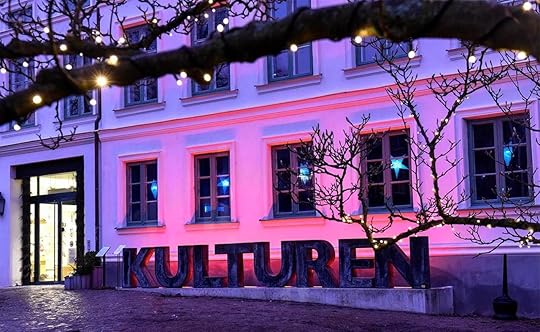
Photo: Kulturen/Facebook
Lund’s central position in the Öresund region, combined with its young population, makes its cultural scene unique. The town has several theaters, the main one being Lunds Stadsteater, with cultural programs and student productions all year. Among Lund’s many museums, Kulturen is the best one to get a glimpse of Swedish life from the past to the present day. Opened in 1892, it’s an open-air museum featuring beautiful gardens and historic houses, as well as temporary and indoors exhibitions.
A short walk away from Kulturen, you’ll find museums like Skissernas, the Museum of Sketches and Public Art, with its extensive art collections and a sculpture park in front. The Historical Museum and the Zoology Museum are smaller museums, both part of Lund University, that hold fascinating collections and are also important research laboratories. Shopping enthusiasts will find several shopping streets and a variety of stores in the city center — including clothing boutiques, Scandinavian home design stores, bookshops, and plenty of second-hand shops.
Nature and green spaces in the city and very close by

Photo: kimson/Shutterstock
Nature is an important part of the Swedish way of life, and wherever you are in Lund there’s always a park or green space nearby. Beyond the Lundagård cathedral garden mentioned above, two main large parks are worth a visit. The Botanical Garden of Lund has a rainforest, desert, and unusual plants while the Stadsparken, or “city park,” is a good place to enjoy hammocks, a skateboard park, barbecue grills, a lovely pond, and gardens.
If it’s summertime, you could take a bus to Lomma beach. On warm days, it’s filled with local families and students picnicking, sunbathing, or going for a swim. You’ll also get a unique view on the nearly five-mile Öresund bridge that links Sweden and Denmark. You could also take a walk on Sankt Hans Hill on the northwest edge of Lund. This area overlooking the city, far from the busy city center, is a favorite place for locals to run, bike ride, or relax.
A short bus ride from Lund will take you to plenty of wild areas for hiking or day trips. The Skrylle nature reserve area is just six miles away, and some of its hiking paths are part of Skåneleden, an over 770-mile-long trail around southern Sweden. You can also take a bus to Söderasen National Park, one of the largest areas of protected woodland in Northern Europe. Admire its forested views from Kopparhatten; at only 700 feet, it’s nonetheless the highest point in southern Sweden. 

More like this: Spend a weekend in Aarhus for a deeper look at life in Denmark
The post Lund is Sweden’s coolest university town appeared first on Matador Network.

Matador Network's Blog
- Matador Network's profile
- 6 followers



